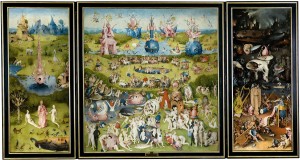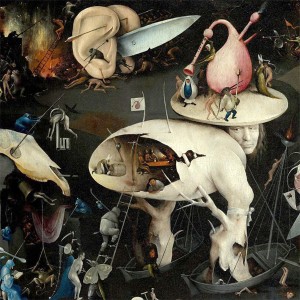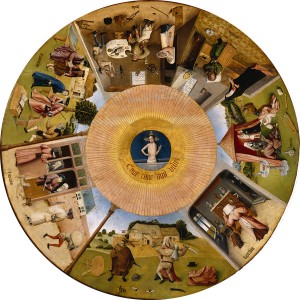Hieronymous Bosch is a fascinating creator of Christian Mandalas. He was a Dutch painter born around 1450, and died in 1516. Only one year before Martin Luther posted his 95 Theses.
Not a lot is known about Bosch, from a biographical standpoint. We do know that he was a member of an orthodox Christian group: The Brotherhood of Our Blessed Lady. Based on what is known about the Brotherhood and Bosch’s paintings, the group and its members were likely conservative.
Bosch’s most famous painting is The Garden of Earthly Delights, (not to be confused with Herrad von Landsberg’s encyclopedia, A Garden of Delights). Click here to see a larger image on Wikipedia Be aware, that this is a very intense piece of art, and contains some PG-13 content.
Briefly, The Garden of Earthly Delights is composed of three panels. The panel on the left depicts Paradise. The panel in the middle is, as the title would suggest, a garden of earthly delights. Here, mankind has completely given into sin. The final panel portrays Hell, and illustrates the punishments according to what people did while they lived ‘in the flesh’ at the garden of earthly delights.
Bosch’s depiction of Hell is both unusual and creative. It’s fascinated both the casual viewer and professional artists for over 500 years. The image below zooms in on a portion of Bosch’s Hell, affectionately known as The Tree Man.
The Tree Man employs Surrealist techniques long before the movement itself began. One of the techniques is the presence of strange juxtapositions within the artwork. In addition, there is the assigning of properties to an object that doesn’t normally possess those properties. This is present both in The Tree Man and in other elements of Bosch’s Hell.
Ultimately, Bosch’s rendering of Hell has a psycological feel that the modern viewer can analyze (even if you haven’t taken Gen Psych). When the painting was created in 1500, Bosch’s intent was likely to teach morality through the piece, while weaving in a healthy dose of fear in the process. Maybe the painting was the 16th century’s version of Scared Straight.
Bosch often used the circular form in his art. Some of these round works may simply be considered Tondos. Tondo is the Italian word used to describe something that’s round or circular. In art, Tondo is used to describe circular art from the Renaissance period. There are quite a few of Bosch’s paintings that fall into this category, such as Christ crowned with Thorns, and The Wayfarer.
On the other hand, some of Bosch’s circular paintings meet the criteria of being a full-fledged mandala. The painting shown above is a mandala called The Seven Deadly Sins, and it breaks out as follows:
At the center of the mandala is the eye of God. In the pupil area is Jesus emerging from a sarcophagus, displaying his wounds. The words below Jesus translate as: “Beware, beware, God sees.”
We now move to the sins which make up the periphery of the mandala. At six o’clock is anger, depicted as two men fighting in front of a tavern.
Moving counterclockwise, we go to the four o’clock position, and the sin of pride. Bosch portrays pride as a vain woman admiring her new hat in front of a mirror. It’s a bit difficult to see, but the mirror is being held by a little demo. Nice touch Hieronymus!
Going to three o’clock, we find a man and woman in a tent near the center of the scene, depicting lust.
At approximately one o’clock, we encounter the next deadly sin: sloth. Here Bosch paints sloth as an overweight man sitting in front of a fire. There is also a woman holding out a rosary, but neither the man nor the woman appears interested in attending to spiritual matters.
Next, at roughly twelve o’clock we come to gluttony. A sad, but humorous scene shows two men eating absolutely everything that’s placed in front of them. The sad part comes from a young child, who is imitating the behavior of the men.
Now at ten o’clock, we come to the sin of greed, rendered as a dishonest judge accepting a bribe.
The final deadly sin is envy, shown at the eight o’clock position. Here, envy is depicted as a rejected suitor, jealously looking at his rival for a young woman’s attention.
On Thursday we’ll look at #5 on the list of Top 10 Christian Mandala Creators. Just about half way through!



